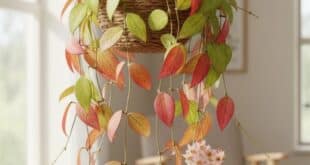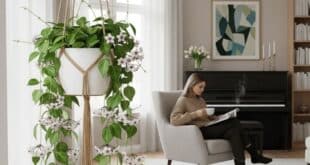Yucca Plant: Your Home’s Bold Statement with Desert Chic!
Ever wished for a tall, architectural plant that looks incredibly strong and stylish, yet asks for very little in return? Say hello to the Yucca plant! This impressive beauty (Yucca elephantipes, also known as Yucca guatemalensis, is the most common indoor type) is a true star in the houseplant world, famous for its spiky, sword-like leaves and sturdy, woody trunk.

Hailing from the arid landscapes of the Americas, the Yucca plant brings a unique blend of desert chic and modern drama to any space. It’s incredibly drought-tolerant and delightfully low-maintenance, making it a perfect choice for beginners or anyone looking for a striking plant that can handle a bit of neglect. Ready to add this bold and resilient plant to your home? Let’s uncover all the secrets to making your Yucca truly flourish!
What Makes a Yucca Plant So Unique? Its Bold, Spiky Look and Woody Trunk
When you look at a Yucca plant, you’ll immediately notice its distinctive appearance. It grows from thick, woody, cane-like stems (trunks) that often stand tall and proud, sometimes with several emerging from the same pot. Topping these trunks are dramatic rosettes of long, sword-like leaves. These leaves are stiff, often a beautiful green or blue-green, and fan out powerfully, creating a striking silhouette. The common indoor variety, Yucca elephantipes, is often called “Spineless Yucca” because its leaves are softer and less sharp than some of its outdoor cousins. It truly adds a bold, architectural touch to any room!
Where Do Yucca Plants Come From? Americas’ Arid Landscapes
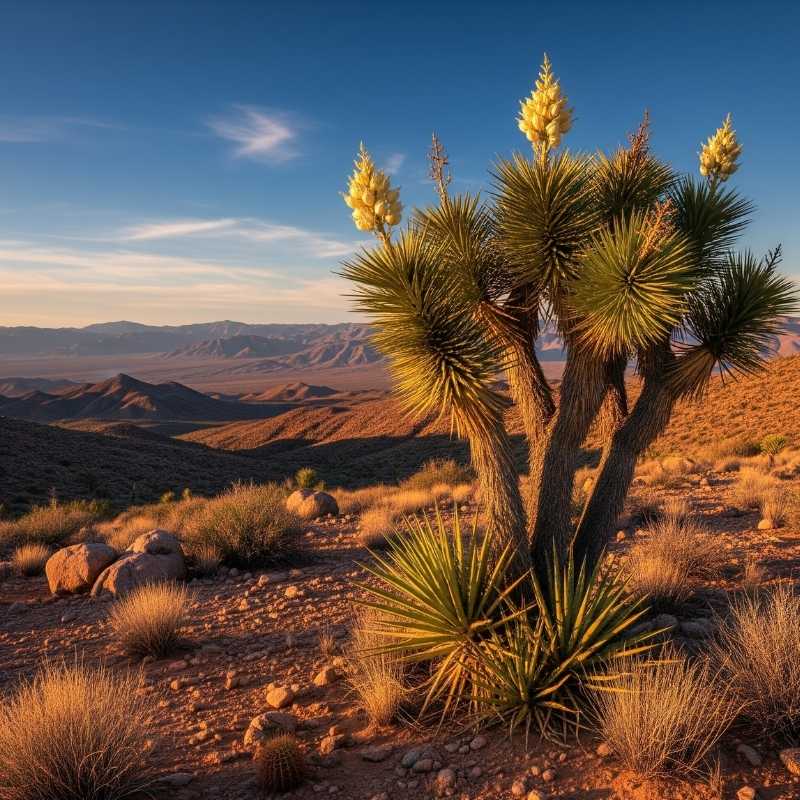
Your Yucca plant’s ancestors come from the dry, sunny deserts, grasslands, and even mountains across North, Central, and South America. Picture a place where the sun blazes intensely, and water is a rare luxury! This background perfectly explains why Yuccas are incredibly drought-tolerant and absolutely adore full sunlight in our homes. They are built tough, ready to thrive even when conditions aren’t perfect.
What Are Its Other Names? “Spineless Yucca” and Its Resilient Charm
The most common nickname for the indoor type of Yucca is “Spineless Yucca” or “Yucca Cane,” distinguishing it from some outdoor varieties like “Adam’s Needle” or “Spanish Dagger,” which have much sharper leaf tips. Its enduring charm comes from its impressive resilience and its ability to maintain its striking looks with minimal fuss – it’s a truly hardy and reliable plant!
What Kinds of Yucca Plants Are There?
The Yucca genus is actually quite diverse, with many species growing outdoors as hardy desert plants. For indoor gardening, one type stands out!
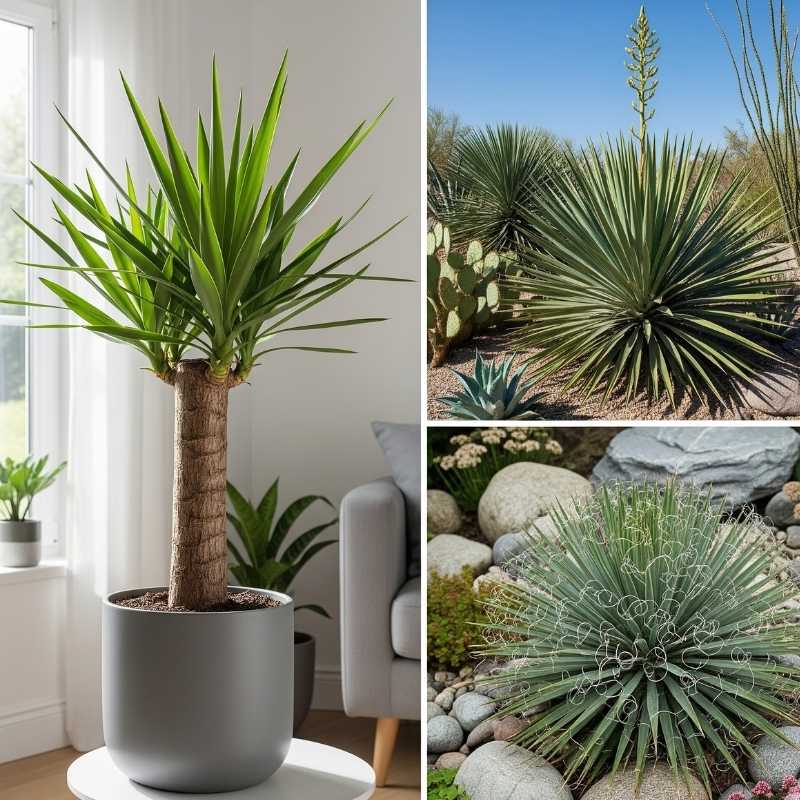
Popular Yucca Types: From Indoor Trees to Outdoor Spikes
When people talk about indoor Yucca plants, they’re almost always referring to Yucca elephantipes (also known as Yucca guatemalensis). Here are a few ways you might see them, along with some common outdoor cousins:
| Type of Yucca | Key Features | Typical Use | Looks Like… |
| Yucca elephantipes (Spineless Yucca/Yucca Cane) | Most common indoor type. Thick, woody canes topped with rosettes of broad, green, soft-tipped leaves. | Indoor floor plant, office decor | A mini, sleek palm tree with spiky leaves. |
| Yucca gloriosa (Spanish Dagger) | Outdoor type. Very stiff, sharp, sword-like leaves. Drought and cold hardy. | Outdoor landscape, desert gardens | A formidable, spiky shrub. |
| Yucca filamentosa (Adam’s Needle) | Outdoor type. Lower-growing, with unique thread-like fibers peeling from leaf edges. | Outdoor perennial, rock gardens | A mound of green spikes with curly “threads.” |
Leaf Looks: Stiff, Sword-like, and Sometimes Striped
The leaves are the main visual appeal of the Yucca! They are characteristically long, sword-like, and stiff, fanning out in striking rosettes from the top of the woody trunks. Most are a beautiful green or blue-green, but some variegated forms exist with lovely yellow or cream stripes down the center or along the edges, adding another layer of visual interest.
Growth Habit: Upright and Tree-like
Yucca plants naturally grow upright, often forming a single tall trunk or multiple “canes” (stems) emerging from the soil. This upright, tree-like growth habit makes them fantastic for adding vertical interest and a sense of architectural style to any room.
How Do You Take Care of Your Yucca Plant?
Caring for a Yucca is wonderfully simple, especially since it’s built to thrive in tough conditions! The main secret is giving it plenty of light and avoiding too much water.
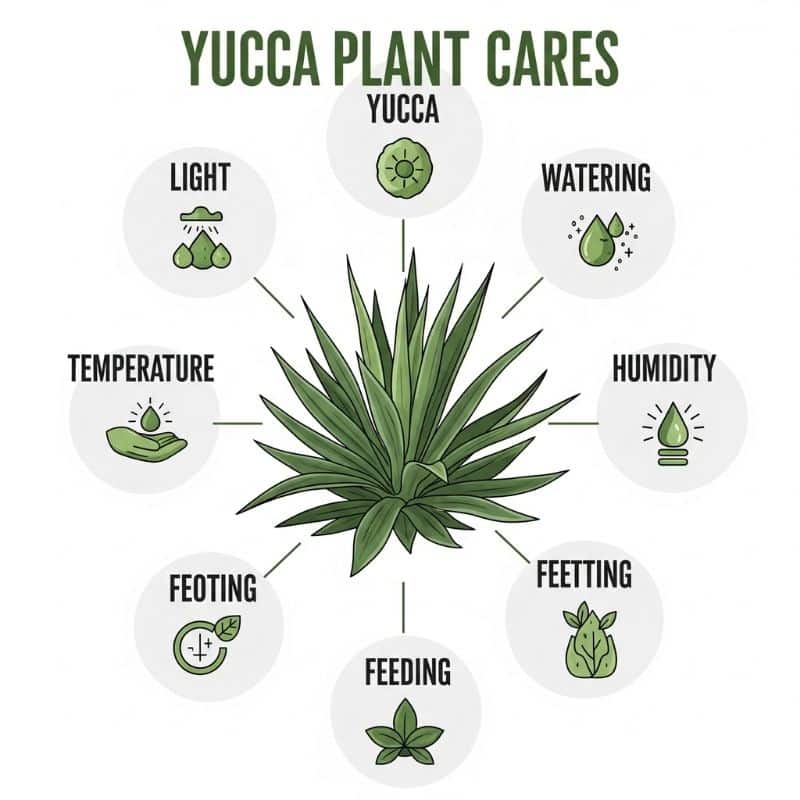
Yucca Plant Care Summary
Here’s a quick overview of what your Yucca loves:
| Care Category | What Your Yucca Needs |
| Light | Plenty of bright, direct sun! (6+ hours daily for best health). |
| Watering | Drought-tolerant. Allow soil to dry out completely between waterings. |
| Soil | Very well-draining, gritty potting mix (like cactus/succulent mix). |
| Temperature | Warm, 60-85°F (15-29°C); avoid cold drafts. |
| Humidity | Average to low indoor humidity; no special needs. |
| Potting | Repot when root-bound (not often), usually in spring. |
| Feeding | Monthly during spring/summer with diluted balanced liquid fertilizer. |
The Right Light: Plenty of Bright, Direct Sun is Best!
This is a super important tip for a happy, thriving Yucca: it absolutely needs plenty of bright, direct sunlight! Aim for at least 6 or more hours of direct sun per day. Think of a sunny, south or west-facing window where it can truly bask in the rays. If your Yucca doesn’t get enough light, it will become leggy (stretched out with sparse leaves), its colors might dull, and it won’t be as robust.
Watering Smart: Less is More! (Drought Tolerant)
Because those thick trunks and leaves store water, Yuccas are wonderfully drought-tolerant. The most important rule: always let the soil dry out completely between waterings. When you do water, do it thoroughly until water drains out the bottom, then wait until the soil is bone dry again before the next drink. Overwatering is the quickest way to make a Yucca unhappy, leading to yellowing leaves and dreaded mushy stem rot. So, when in doubt, hold off on the water! You can water even less frequently during the cooler, less active winter months.
Cozy Temperatures and Low Humidity is Fine!
Your Yucca prefers warm temperatures, ideally between 60-85°F (15-29°C). Keep it away from cold drafts from windows or air conditioners, especially in winter. Good news: Yuccas are perfectly happy with average to low indoor humidity – no need for humidifiers here, which makes them super easy to care for!
Choosing the Right Soil and Pot: Drainage is a Must!
Since they hate wet roots, your Yucca needs super well-draining, gritty potting mix. A cactus and succulent potting mix is absolutely ideal for them. If you’re using regular potting soil, mix in plenty of perlite or coarse sand to ensure excellent drainage. And always, always use a pot with drainage holes! Yuccas grow quite slowly and prefer to be a bit snug, so you won’t need to repot them very often – maybe every 2-3 years, or when roots are clearly coming out of the drainage holes. Spring is typically the best time for repotting.
Feeding Your Yucca Plant: Light Meals During Growing Season
Yuccas aren’t very hungry! You only need to fertilize them sparingly during their active growing season (spring and summer). Use a balanced liquid houseplant fertilizer, diluted to half strength, once a month or even less often. There’s no need to fertilize at all during the fall and winter.
What Are Common Problems with Yucca Plants and How to Fix Them?
Yuccas are incredibly tough, but they will definitely tell you if something’s not quite right. Here’s what to look for:
Common Yucca Plant Problems & Solutions
| Problem | What It Looks Like | Common Cause(s) | How to Fix |
| Yellowing Lower Leaves | Lower leaves turn yellow, then brown | Overwatering (most common); sometimes natural aging for lowest leaves. | Let soil dry out completely between waterings. Ensure perfect drainage. Remove yellowed leaves. |
| Brown Tips or Spots | Leaf tips are dry, brown, or crispy | Underwatering (plant too dry for too long), low humidity (less common culprit). | Adjust watering schedule to be more consistent. While not humidity lovers, extreme dryness can show. |
| Mushy Stem/Trunk | Base of plant or trunk feels soft and squishy | Root rot from persistent overwatering (most severe problem). | This is often fatal. Prevention is key! Ensure perfect drainage and never overwater. If caught early, try repotting into bone-dry soil after trimming mushy roots. |
| Leggy Growth or Dull Leaves | Stretched out stems, sparse leaves, muted color | Not enough light | Move to a brighter spot with plenty of direct sunlight. |
| Pests | Sticky residue, small bugs | General plant stress | Inspect regularly (especially undersides of leaves). If pests are detected, treat the plant with insecticidal soap or neem oil. |
Is the Yucca Plant Toxic? Safety for Pets
Yes, it’s very important to know: Yucca plants are considered toxic if ingested. They contain compounds called saponins, which can be irritating.
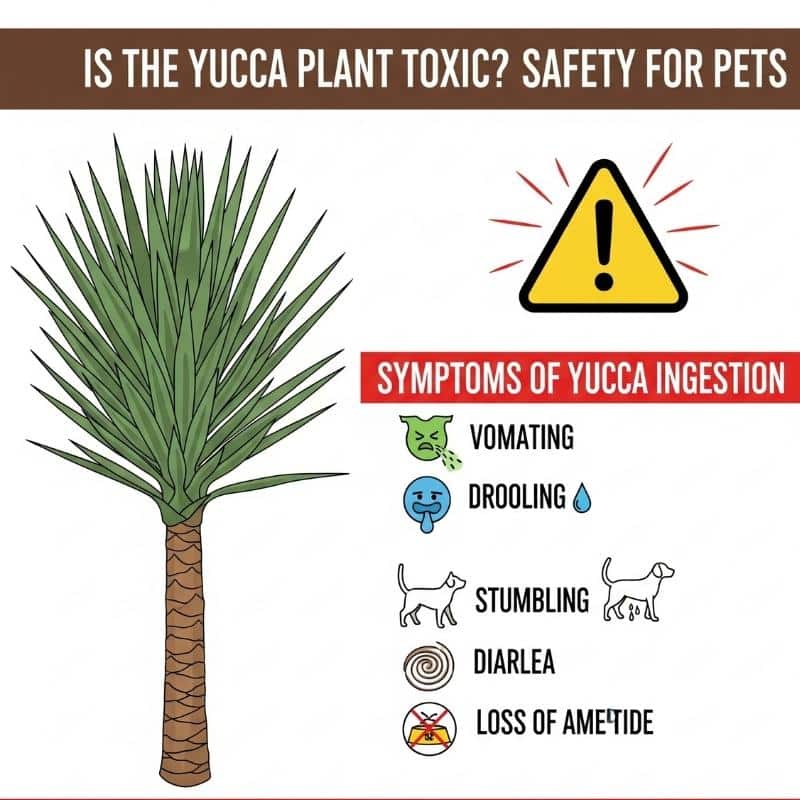
If your cats, dogs, or other pets chew on a Yucca plant, you might see symptoms like:
- Vomiting: This is the most common reaction.
- Diarrhea.
- Excessive drooling.
- Weakness or lethargy.
- Ataxia (stumbling or difficulty walking): This is a specific symptom to watch for with Yucca ingestion.
While usually not life-threatening (unless a very large amount is consumed, which is rare), it can cause significant discomfort for your pets. Therefore, it’s highly recommended to keep Yucca plants out of reach of curious pets and small children. If you think your pet has eaten any part of a Yucca and shows symptoms, please contact your veterinarian immediately for advice.
Yucca Plant for Home Decor: Modern Drama and Desert Chic
The Yucca plant is a decorator’s dream, bringing both impressive height and sophisticated style to any room:
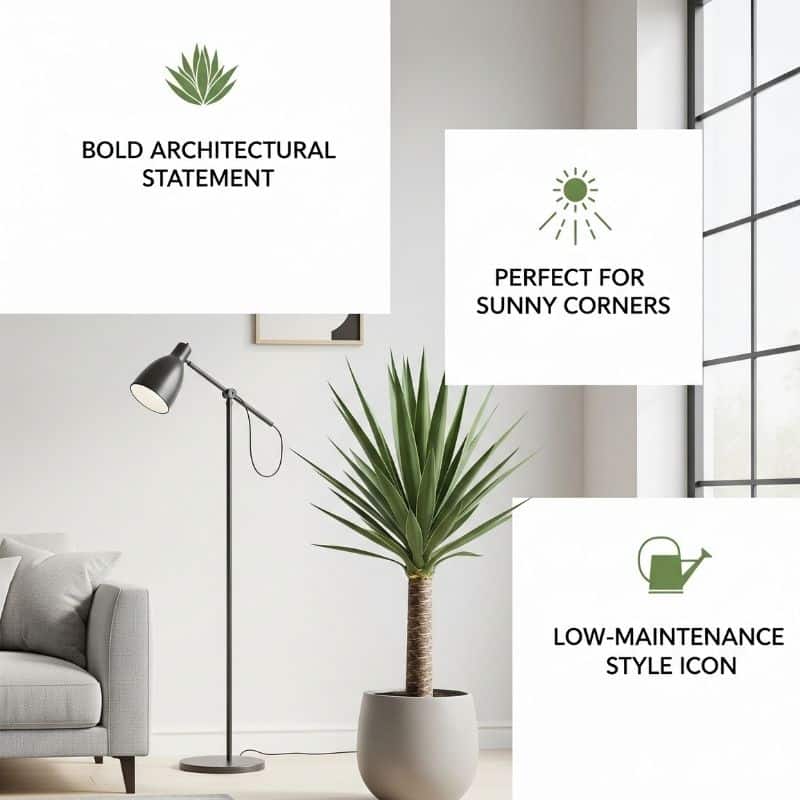
Creating a Bold, Architectural Statement
With its strong, upright lines and dramatic spiky foliage, a Yucca plant can instantly become a magnificent architectural statement in your home. It adds a powerful visual presence that fits perfectly with modern, minimalist, or desert-inspired decor.
Perfect for Sunny Corners and Entrances
Since it absolutely loves bright, direct sunlight, the Yucca is ideal for those sunny corners, entryways, or well-lit rooms where it can truly bask and show off its glory. It’s a fantastic way to fill a tall, empty space with life.
Low-Maintenance Style Icon
The Yucca truly is a style icon that doesn’t demand much! Its drought tolerance and minimal care needs mean you get maximum impact with minimal fuss. It’s perfect for busy individuals who still want a touch of sophisticated greenery.
The Allure of Yucca Plants: Tough, Trendy, and Tall
The Yucca plant truly stands out as a top choice for indoor gardeners. It offers an unbeatable blend of impressive architectural form, surprising drought tolerance, and a wonderfully low-maintenance routine. Whether you’re looking for a striking vertical accent, a touch of desert-inspired elegance, or simply a reliable green companion that thrives on bright light and minimal watering, the Yucca is a wonderfully rewarding choice. It’s a testament to enduring beauty that will enrich your home for years to come.
Frequently Asked Questions (FAQ) About Yucca Plants
Still have some questions about your wonderful Yucca plant? Here are some common ones that might help you out!
Q1: How often should I water my Yucca plant?
A1: Water your Yucca plant when the soil has completely dried out from top to bottom. This is crucial! Depending on light, temperature, and pot size, this could be every 2-4 weeks, or even less often in winter. When you do water, do it thoroughly until it drains out the bottom.
Q2: Why are my Yucca’s lower leaves turning yellow?
A2: Yellowing lower leaves are typically a sign of overwatering. Excessively wet soil can lead to root problems. Adjust your watering schedule to let the soil dry out completely between drinks. It can also be natural aging for the very lowest leaves, but this usually happens slowly.
Q3: Does a Yucca need direct sunlight?
A3: Yes, for the best growth and health, Yucca plants need plenty of bright, direct sunlight – ideally 6 or more hours of direct sun per day. A south or west-facing window is usually best. Less light will lead to leggy growth and duller leaves.
Q4: Can I cut the top off my Yucca?
A4: Yes, you absolutely can! This is a common way to control its height or to encourage new growth and branching. When you “top” a Yucca cane, new rosettes of leaves will typically emerge from just below the cut. You can even attempt to root the cut-off top!
Q5: Is the Yucca plant safe for pets?
A5: No, Yucca plants are considered toxic if ingested by cats, dogs, and other pets. They contain saponins that can cause vomiting, diarrhea, weakness, and stumbling. It’s best to keep them out of reach of curious pets.
Q6: How tall can a Yucca plant get indoors?
A6: Indoors, with good care, a Yucca plant (Yucca elephantipes) can typically reach heights of 4-8 feet (1.2-2.4 meters), and sometimes even taller, making it a very impressive floor plant.
Q7: Why are my Yucca’s leaf tips turning brown and crispy?
A7: Brown, crispy tips are usually a sign of underwatering (the plant is consistently too dry) or sometimes low humidity (though they tolerate dry air well, extreme dryness can show). Also, using tap water with high mineral content can contribute over time.
Q8: What’s the best soil for a Yucca?
A8: The best soil is a very well-draining, gritty mix, specifically a cactus and succulent potting mix. If using regular potting soil, make sure to add plenty of perlite or coarse sand to improve drainage.
Q9: Do Yucca plants bloom indoors?
A9: It’s very rare for indoor Yucca plants to bloom, but it can happen under ideal conditions (lots of sun, maturity). When they do, they send up a tall stalk with clusters of white or cream-colored, bell-shaped flowers. Most people grow Yuccas for their impressive foliage.


